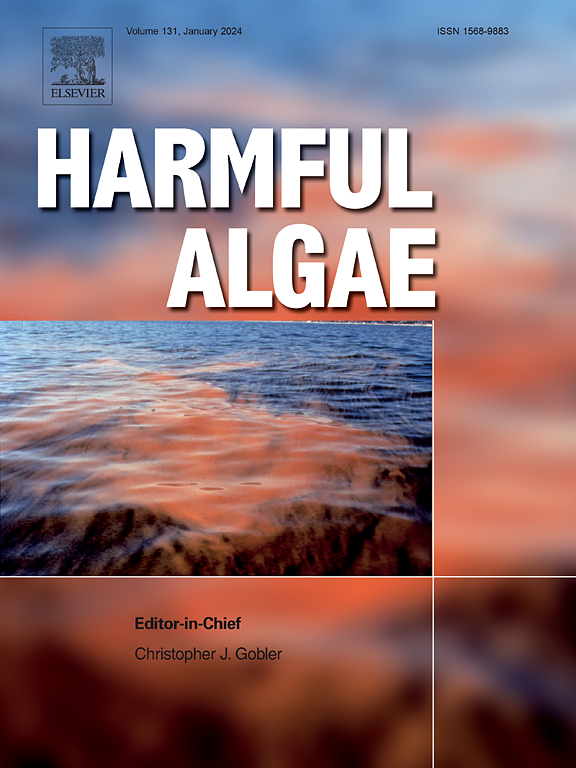Physiological changes and gene expression in the mixotrophic haptophyte, Prymnesium parvum, respond to mixed nitrogen sources
IF 4.5
1区 生物学
Q1 MARINE & FRESHWATER BIOLOGY
引用次数: 0
Abstract
Prymnesium parvum is a toxin-producing haptophyte that adapts to various conditions in aquaculture wastewater, using strategies like allelopathy, toxicity, and predation to survive. However, knowledge about physiological and genetic responses of P. parvum to mixed nitrogen sources in aquaculture wastewater is still limited. Here, we cultured P. parvum in simulated aquaculture wastewater nitrogen composition, and revealed physiological and gene expression responses of P. parvum to mixed nitrogen sources. Under high concentrations mixed nitrogen sources (8.83 × 103 μmol/L), P. parvum shows strong adaptability and competitiveness, predisposing it to harmful algal blooms (HABs) outbreaks. At low concentrations 8.83 × 101 μmol/L), it compensates by consuming other algae and producing toxins for defense. Transcriptomic data indicate that P. parvum upregulates nitrogen-related genes when transitioning from nitrate to mixed nitrogen, and downregulates them with increasing concentrations, significantly impacting glutamate metabolism and potentially enhancing direct ammonia conversion to l-glutamate, bypassing l-glutamine. Metabolic reprogramming in P. parvum may drive cell proliferation and HABs formation, with ecological consequences for aquaculture nitrogen dynamics.
混合营养苔藓小樱草对混合氮源的生理变化及基因表达
parvum Prymnesium parvum是一种产生毒素的触媒植物,它适应水产养殖废水中的各种条件,利用化感作用、毒性和捕食等策略生存。然而,关于小孢子虫对水产养殖废水中混合氮源的生理和遗传反应的认识仍然有限。本研究在模拟水产养殖废水氮组成中培养细小疟原虫,揭示了细小疟原虫对混合氮源的生理和基因表达反应。在高浓度混合氮源(8.83 × 103 μmol/L)条件下,小单胞藻表现出较强的适应性和竞争力,易发生有害藻华(HABs)。在低浓度(8.83 × 101 μmol/L)时,它通过消耗其他藻类和产生毒素来进行防御。转录组学数据表明,parvum在从硝酸盐过渡到混合氮的过程中上调氮相关基因,并随着浓度的增加而下调,显著影响谷氨酸代谢,并可能通过l-谷氨酰胺促进氨直接转化为l-谷氨酸。parparum的代谢重编程可能驱动细胞增殖和有害藻华的形成,并对水产养殖氮动力学产生生态影响。
本文章由计算机程序翻译,如有差异,请以英文原文为准。
求助全文
约1分钟内获得全文
求助全文
来源期刊

Harmful Algae
生物-海洋与淡水生物学
CiteScore
12.50
自引率
15.20%
发文量
122
审稿时长
7.5 months
期刊介绍:
This journal provides a forum to promote knowledge of harmful microalgae and macroalgae, including cyanobacteria, as well as monitoring, management and control of these organisms.
 求助内容:
求助内容: 应助结果提醒方式:
应助结果提醒方式:


